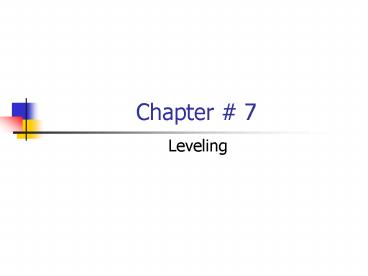Leveling - PowerPoint PPT Presentation
1 / 18
Title:
Leveling
Description:
Is a relatively permanent point of known ... Anchor Tripod legs firmly ... On slopping ground, two of the tripod legs should be placed on the down hill side. ... – PowerPoint PPT presentation
Number of Views:20
Avg rating:3.0/5.0
Title: Leveling
1
Chapter 7
- Leveling
2
Differential Leveling
- Necessary Definitions
- A Bench Mark (BM)
- Is a relatively permanent point of known
elevation. A bench mark should easily be
recognized and found, and should be set fairly
low in relation to to the surrounding ground. - A Turning Point (TP)
- Is a temporary point whose elevation is
determined during the process of leveling. It is
recommendable to use points that are easily
identifiable so that the level rod can be removed
and put back as many times as required.
3
Differential Leveling
- Necessary Definitions
- A Back Sight (BS)
- Is a sight taken to the level rod held on a point
of known elevation, it can be either a BM or a TP
to determine the height of an instrument (HI). - A Foresight (FS)
- Is a sight taken to any point to determine its
elevation. The only limitation to the number of
sights are the length of the rod and the power of
the telescope on the level.
4
Differential Leveling
- Is the process of determining the difference in
elevation between 2 points. The initial BS can be
taken to be a point of known elevation, a bench
mark, or to a point of assumed elevation. If the
starting point is a BM the elevations for the
subsequent points are actual elevations. - However if the elevation of the starting point is
an assumed elevation, than the elevation of the
subsequent points are considered relative
elevations.
5
Differential leveling
6
Earth Curvature and Atmospheric Refraction
- To this point we have been assuming that when the
instrument is leveled, its line of sight will
represent a level line. - This is not truedue to atmospheric refraction.
- When rays of light pass through air strata of
different densities, they are refracted, or bent
downward. This amount of refraction is dependent
on temperatures, pressures, and relative
humidities.
7
Corrections
- Accounting for earth curvature
- D2 E2 ( EC)2
- this is equivalent to C 0.0001263 D2 miles
- When we change the value to feet
- C (0.0001263)(5280) 0.667 D2 ft
- Due to refractions
- An average value is assumed 0. 093 ft in 1 mile
sight distance. - Note that the errors are compounded
8
Corrections
9
Corrections
- The combination of the earth curvature, and
atmospheric refraction - C (0.667 0.093) 0.574 ft in 1 mile.
- C 0.574 M2
- For SI units C 0.0675 k2, C is in meters, and
k is distance in Km.
10
Verniers
- Is a device for making readings on a divided
scale closer than the smallest division on the
scale. Was invented in 1620 by Pierre Vernier a
Frenchman. - On rod readings, most verniers scales are of 10
divisions, or the measurements can be accurate to
the 0.001 ft. - 10 divisions on the verniers scale coincide with
9 divisions on the rod, I.e. each division on
the vernier is 0.009 ft.
11
Verniers how does it work?
- To read the a level rod vernier, the bottom of
the vernier is lined up with the horizontal cross
hair and the reading is determined by counting
the number of vernier divisions until a division
on the vernier coincides with a division on the
rod. This reading is than added to the last
division on the rod below the bottom of the
vernier.
12
Verniers
13
Level Rod Targets
- For long sights or for situations in which
readings to the nearest 0.001 ft are desired, a
level rod target may be used. Targets are small
elliptical pieces of metal painted in red and
white, a vernier is part of the target.
14
Rod Target
15
Common Mistakes
- Misreading the Rod
- Moving turning points
- Field note mistakes
- Mistakes with extended rods
16
Leveling errors
- Level rod not vertical
- Settling of level rod
- Mud or snow accumulated on base of the rod
- Rod not fully extended
- BS and FS distances not equal
- Bubble not centered on level
- Improper focusing of telescope
- Heat waves
- Wind
17
Suggestions for good leveling
- Anchor Tripod legs firmly
- Check to be sure that bubble tube is centered
before and after rod readings - Take as little time as possible between BS and FS
readings - Try to set up the level as distances from BS and
FS are equal - Provide rodmen with level rods that have level
tubes so the rods can be plumbed or they can
wave the rod slowly toward and away from the
instrument - On slopping ground, two of the tripod legs should
be placed on the down hill side.
18
Precision of Differential Leveling
- Rough Leveling
- or 0.4 ?M
- Average
- or 0.1 ?M
- Excellent
- or 0.05 ?M
- M is the number of miles leveled.































